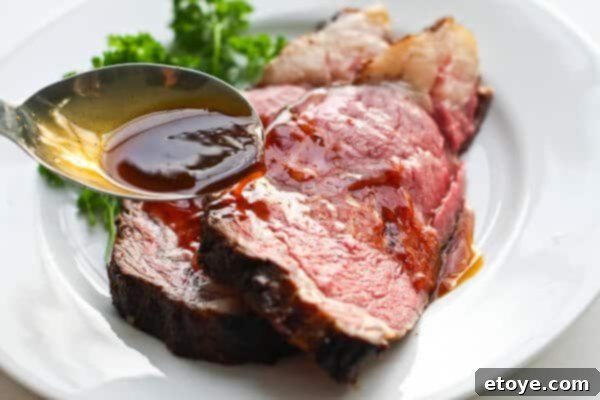Welcome to the ultimate guide for preparing a truly unforgettable Prime Rib Roast, a dish synonymous with festive celebrations and special gatherings. This isn’t just a recipe; it’s a meticulously crafted method designed to deliver a Prime Rib that is consistently tender, incredibly juicy, and bursting with flavor. The secret lies in a two-stage cooking process: an initial high-temperature sear to lock in the juices and develop a rich, savory crust, followed by a slow, gentle roast at a lower temperature. This combination ensures an even cook from edge to center, resulting in a show-stopping centerpiece that will impress even the most discerning palates. Get ready to elevate your culinary skills and create a magnificent Prime Rib that will be the highlight of any holiday table or special occasion.
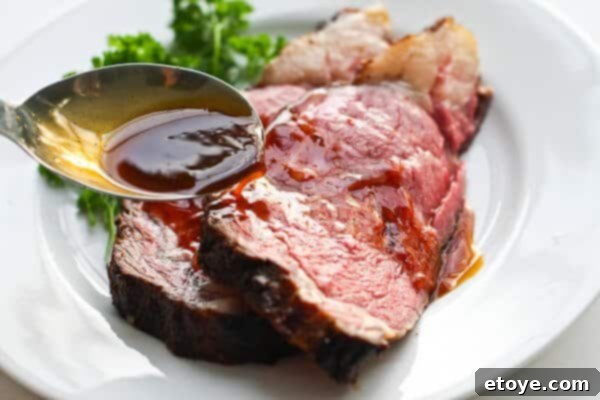
Why This Prime Rib Recipe is Absolutely Essential for Your Repertoire
- Unrivaled Tenderness and Juiciness: Experience melt-in-your-mouth perfection with every slice. Our method ensures the beef remains incredibly moist and tender, even if cooked slightly beyond your preferred doneness, thanks to the slow-roasting technique.
- A Truly Foolproof Method: Designed for success, this recipe minimizes guesswork. With the aid of a reliable meat thermometer, achieving the ideal internal temperature for your desired doneness becomes incredibly straightforward, making it accessible for home cooks of all experience levels.
- Deeply Flavorful Red Wine Jus: More than just a sauce, our accompanying red wine jus is a deeply savory, rich reduction crafted from roasted oxtail bones and aromatic vegetables. It perfectly complements the prime rib, adding an exquisite layer of flavor that elevates the entire dish.
- Ideal for Entertaining: Whether you’re hosting an intimate family dinner or a grand holiday feast, this prime rib recipe scales beautifully. A substantial roast serves a large crowd effortlessly, making it the perfect choice for making a grand statement at your next gathering.
Essential Ingredients for Your Perfect Prime Rib
- Bone-on Beef Rib Roast: Opt for a high-quality, bone-in rib roast, preferably from the first-cut (ribs 9-12), which offers the best marbling and flavor. A “Choice” grade from your local supermarket is excellent and doesn’t require the expense of “Prime” grade.
- Oxtail Bones: These are the secret weapon for an unbelievably rich and deeply flavored red wine jus, providing a profound beefy foundation.
- Tomato Paste: Used to coat the oxtail bones, it caramelizes during roasting, contributing an extra layer of umami and color to the jus.
- Aromatic Vegetables: A classic mirepoix of **onions, carrots, and celery** forms the flavor base for the jus, infusing it with sweetness and earthiness.
- Garlic: A whole head, halved, adds a pungent and aromatic depth to both the roast and the jus.
- Cooking Oil: Essential for searing the roast and roasting the vegetables and oxtails, ensuring proper browning and flavor development.
- Red Wine: A dry red wine (such as Cabernet Sauvignon or Merlot) is crucial for deglazing the pan and forming the luscious red wine jus. Its acidity balances the richness of the beef.
- Chicken & Beef Broth: A combination of broths adds complexity and liquid for simmering down into a concentrated jus.
- Fresh Thyme: The herbaceous notes of fresh thyme complement beef beautifully, adding an aromatic freshness to the jus.
- Salt and Pepper: Generous seasoning is key to enhancing the natural flavors of the beef and creating that irresistible crust.
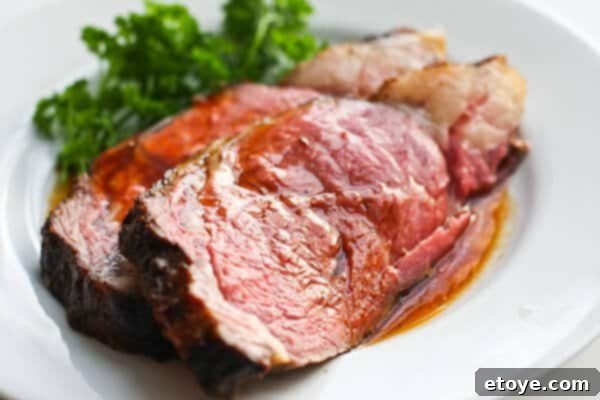
Mastering the Art of Prime Rib: Simpler Than You Think
Don’t let the grandeur of a prime rib roast intimidate you. This recipe is surprisingly straightforward, bordering on foolproof, especially when you have a trusty meat thermometer by your side. Even if you happen to leave it in the oven a tad longer than intended, the slow-and-low roasting temperature is incredibly forgiving, ensuring your roast remains wonderfully moist and tender.
A common misconception is that you need an expensive “Prime” grade cut of beef for a magnificent prime rib. However, the term “prime” in Prime Rib Roast refers to the cut of meat, not necessarily the USDA grade. A “Choice” grade rib roast, readily available at most supermarkets, is absolutely perfect for this recipe. It offers excellent marbling and flavor without the significant splurge often associated with “Prime” grade beef, proving that you can achieve exceptional results without breaking the bank.
For those eager to experiment with advanced techniques, dry-aging your roast can further enhance its flavor and tenderness. While entirely optional, it’s a process that concentrates the beef’s natural flavors and can be a rewarding endeavor for the adventurous cook. If you’re considering it, starting the dry-aging process now would be ideal for upcoming special occasions. However, rest assured that even without dry-aging, this recipe will yield a prime rib that’s spectacular. This recipe is inspired by the meticulous culinary experts at Cook’s Illustrated, with a few personal adjustments that have consistently delivered perfect results every single time.
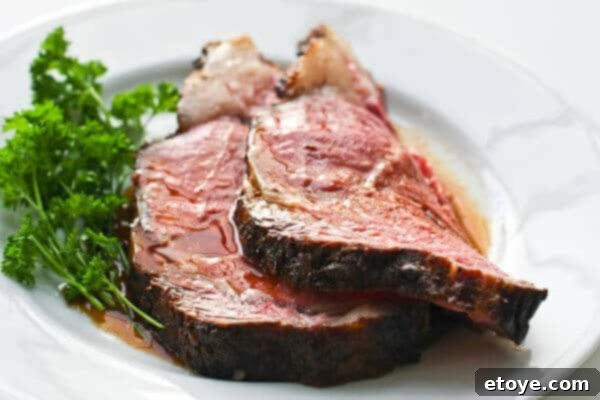
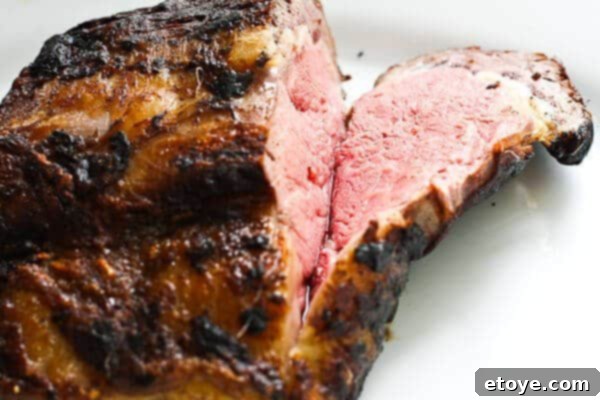
Step-by-Step Guide to Cooking the Perfect Prime Rib with Rich Red Wine Jus
Creating this masterpiece is a rewarding culinary journey. Follow these detailed steps to achieve a truly memorable prime rib.
Phase 1: Preparing the Foundation for the Jus
Begin by preheating your oven to 400°F (200°C) with the rack set to the lowest position. Take your oxtail bones and smear them generously with tomato paste. This crucial step helps to caramelize the bones and tomato paste during roasting, creating an incredibly deep, complex flavor for the red wine jus – a component so delicious, it accounts for a significant portion of this dish’s appeal! Place the coated oxtails in your roasting pan. Add the quartered onions, carrots cut into thirds, celery stalks, and halved head of garlic to the pan, tossing them with just one tablespoon of cooking oil. Roast these for 20 minutes to give them a head start in developing rich flavors.

After the initial roasting period, observe the rich color and fragrant aroma emanating from the pan. The oxtails and vegetables will have taken on a beautiful golden-brown hue, indicating the deep flavors they will impart to your jus.
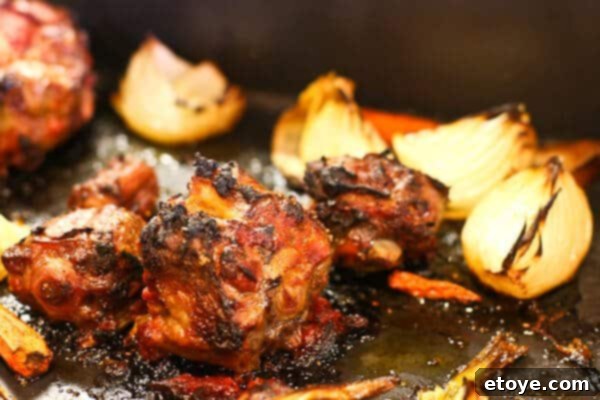
Phase 2: Preparing and Searing the Rib Roast
While the oxtails and vegetables roast, prepare your prime rib. Instead of attempting to carve the roast off the bone *after* cooking, a technique championed by Cook’s Illustrated recommends carving the meat off the bone *before* roasting. This offers two significant advantages:
- It makes carving for serving much easier, as you won’t have to contend with a hot, slippery bone.
- The separated bones can then be used later in the cooking process to further flavor the au jus, maximizing their contribution.
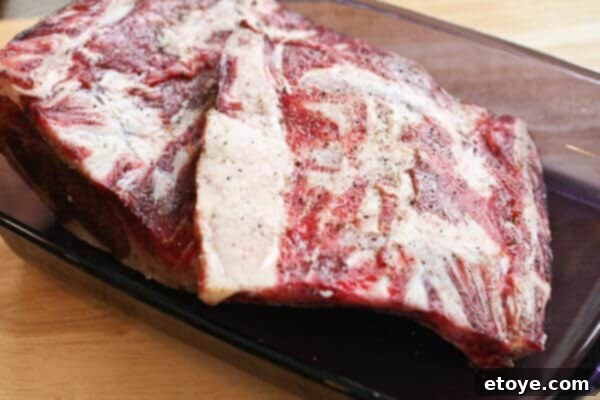
Carefully cut the roast as close to the bone as possible to ensure no precious meat is wasted. Once separated, pat the boneless roast dry with paper towels. Rub the roast with the remaining tablespoon of cooking oil and season it generously with salt and freshly ground black pepper on all sides.
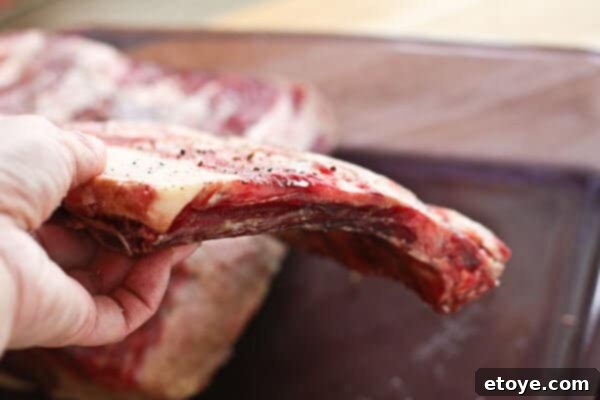
Heat a large frying pan or a cast iron skillet (which is highly recommended for its heat retention) over high heat until it’s smoking hot. Place the boneless rib roast, fat side down, into the hot pan and sear each side for approximately 5 minutes until a beautiful, deep brown crust forms. This searing process is vital for locking in juices and developing incredible flavor.
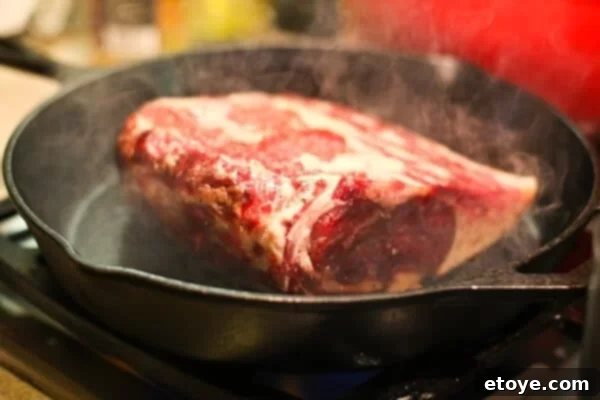
Ensure you achieve a rich, crusty exterior on all sides of the roast.
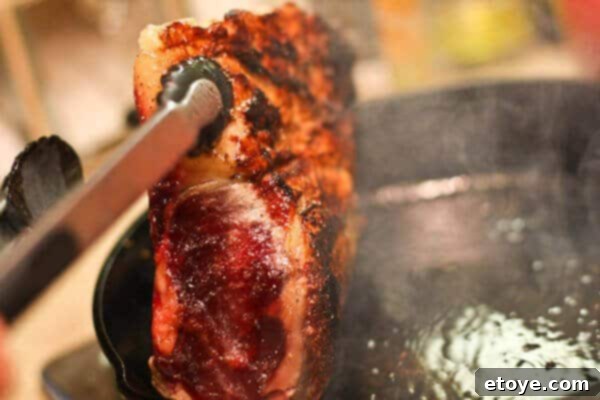
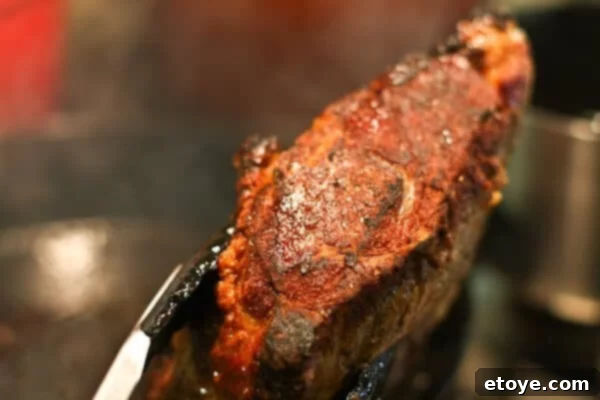
Phase 3: Roasting the Prime Rib
Once seared, remove the roast from the pan and let it cool for a few minutes. Now, carefully reassemble the roast by tying it back onto its bones. Strips of cheesecloth work exceptionally well for this – they are easier to manage than traditional kitchen twine and that elaborate fancy tying technique. Two strips are usually sufficient; simply tie it as you would a gift.

This step of tying the roast back onto the bones is vital for several reasons. Firstly, the bones act as a natural “rack” in the roasting pan, lifting the meat slightly to allow for more even heat circulation and cooking. Secondly, the bones themselves continue to impart flavor to the roast as it cooks, and later to the jus. When the initial 20 minutes for the oxtails and vegetables is up, remove the roasting pan from the oven. Push the roasted oxtails and vegetables to the sides of the pan. Place the tied roast, bone-side down, in the center of the roasting pan. Reduce the oven temperature to 250°F (120°C).
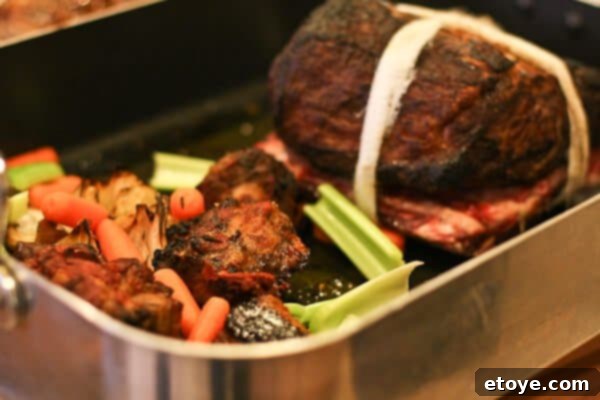
Return the pan to the oven and roast for approximately 17-20 minutes per pound. For a 7-pound roast, this would be about 2 hours. However, the most reliable way to determine doneness is by using a meat thermometer. Insert the thermometer deep into the thickest part of the roast, ensuring it doesn’t touch any bone. Aim for an internal temperature of 122°F (50°C) for rare, or 130°F (54°C) for medium-rare. Remember, the temperature will rise further during resting.
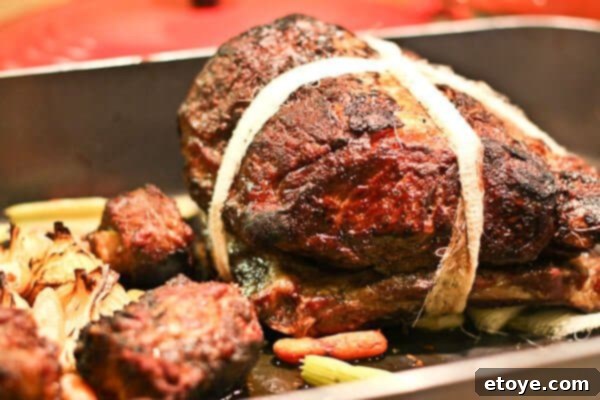
Once your desired temperature is reached, carefully transfer the roast to a cutting board. Gently untie the bones from the roast. Cover the roast loosely with aluminum foil and allow it to rest for at least 20 minutes. This resting period is crucial as it allows the juices to redistribute throughout the meat, ensuring a tender and moist final product.
Phase 4: Crafting the Savory Red Wine Jus
While the roast rests, it’s time to create the incredible red wine jus. Keep the oxtails and roasted vegetables in the roasting pan. Carefully spoon out all but about 1 teaspoon of the rendered fat from the pan. (This rendered beef fat is liquid gold – perfect for making Yorkshire Pudding!). Now, add the bones you untied from the roast back into the roasting pan with the oxtails and vegetables. Place the roasting pan over two burners set to high heat.

Pour in the red wine and bring it to a vigorous simmer, scraping up all the delicious browned bits from the bottom of the pan with a wooden spoon. Continue to cook until the wine has reduced by half. Then, add the beef broth, chicken broth, and fresh thyme sprigs. Reduce the heat to medium-low and let it simmer gently for about 15 minutes, allowing the flavors to meld and deepen. During this time, any juices that have accumulated on the cutting board from the resting roast should be added to the jus for extra flavor. Turn off the heat.
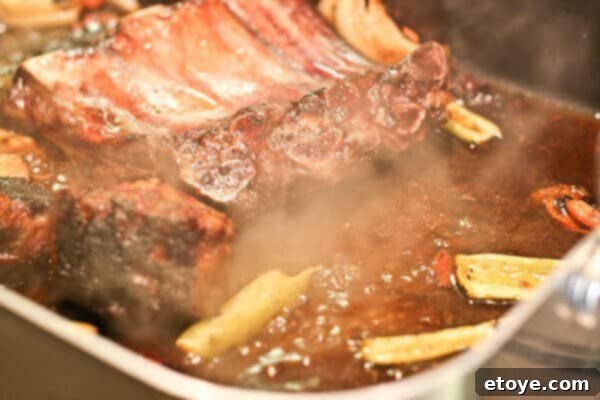
Carefully remove the oxtail bones and the roast bones from the pan. Strain the jus through a fine-mesh strainer into a clean saucepan or heat-proof container, pressing down firmly on the vegetables with a wooden spoon to extract every last drop of flavorful liquid.

And just like that, your exquisite red wine jus is complete!

Phase 5: Carving and Serving
Now, with the roast perfectly rested, it’s time to carve. Slice the prime rib against the grain into your desired thickness.
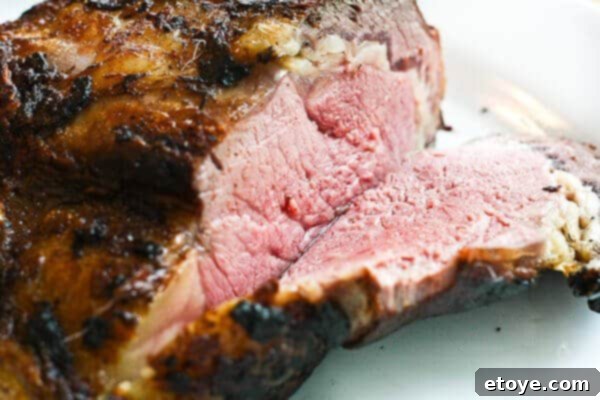
Serve each glorious slice of prime rib with a generous drizzle of the warm, savory red wine jus. Prepare for applause!
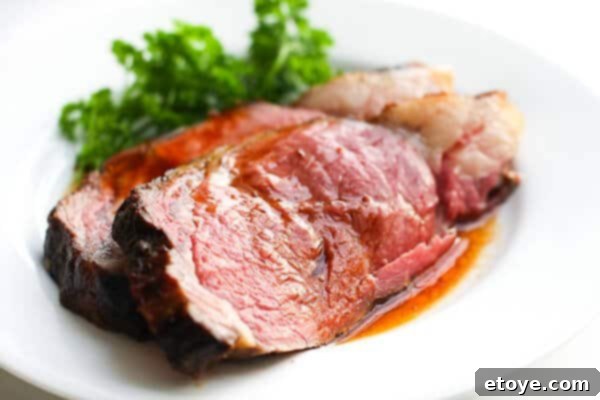
And don’t forget a special treat for your furry best friend – the cooked bones (once cooled and stripped of any sharp fragments) can make a wonderful, safe chew for them!

Check out this beautiful Prime Rib recipe made by Steph from Faye Bernoulli blog. Here’s her photo showcasing the delicious result!
Adjusting Your Prime Rib Recipe for Larger Roasts
The question of how to handle larger roasts is a common one, especially during holiday planning. Let’s address it directly:
Q: I have a 12-pound roast. Can you please help me figure out the cooking timing?
A: Hosting a grand party, are we? That’s fantastic!
The roasting time for beef really depends less on the total weight alone and more on the diameter and shape of the meat. A 10-pound roast that is thick and round will naturally take longer to cook through than a 10-pound roast that is longer and thinner, simply because heat takes longer to penetrate thicker cuts of meat. While 17-20 minutes per pound for a 12-pound roast provides a good initial estimate, approximately 3.5 to 4 hours, this is just a starting point. The true timing will be influenced by the exact dimensions of your specific roast.
To assess your roast, compare its dimensions to the images in our step-by-step guide. Is your 12-pound roast simply longer, implying more ribs, but with a similar thickness? Or did you acquire a significantly thicker, more substantial roast with a similar number of ribs? This visual assessment can help you anticipate how quickly heat will penetrate.
For absolute accuracy and a truly foolproof result, investing in a remote meat thermometer is highly recommended (a reliable one can be found for around $15). This allows you to monitor the internal temperature without opening the oven, ensuring perfect doneness. If you don’t have a remote thermometer, make sure to check the roast’s temperature frequently towards the end of the estimated cooking time.
Given the sheer size of a 12-pound roast, searing all sides in a standard pan can be quite challenging. A clever workaround is to cut the roast in half before searing each half separately. This not only makes handling significantly easier but can also expedite the cooking process. By altering the overall shape and size, heat will penetrate the smaller sections faster. You can then place both halves into separate roasting pans on different oven racks (if you have a convection oven for even heat distribution), or place them both in one large pan, ensuring ample space between them for air to circulate freely. Effectively, you would then be cooking two 6-pound roasts, adjusting your timing to approximately 17-20 minutes per pound for each 6-pound section.
As for the Red Wine Au Jus, you’ll want to increase the quantities to match the larger roast. Multiplying the recipe by approximately 1.5 times should be sufficient. This is a forgiving recipe, so exact measurements aren’t strictly necessary. Trust your judgment and adjust to taste! We hope these tips help ensure your large prime rib roast is a resounding success!
Perfect Accompaniments: What to Serve with Your Prime Rib
A magnificent prime rib deserves equally splendid side dishes. Here are some classic and complementary pairings that will complete your meal:
- Yorkshire Pudding: How can you resist this classic? The rich beef fat rendered from the roasting pan is the key ingredient for these airy, golden popovers. They are the quintessential accompaniment, perfect for soaking up every last drop of delicious jus. You can find our complete Yorkshire Pudding recipe here.
- Roasted Garlic Mashed Potatoes: Creamy mashed potatoes infused with the sweet, mellow flavor of roasted garlic provide a comforting and luxurious counterpoint to the rich beef. A timeless favorite that never disappoints. Discover the recipe for Roasted Garlic Mashed Potatoes.
- Roasted Carrots with Sesame Ponzu Vinaigrette: For a vibrant and slightly unexpected side, roasted carrots offer sweetness and a tender bite, while a zesty sesame ponzu vinaigrette adds a refreshing, tangy contrast. Find the recipe for Roasted Carrots with Sesame Ponzu Vinaigrette.
Top Tips for Ensuring Prime Rib Perfection
- Choose Wisely: Always opt for a bone-in rib roast, preferably a “first-cut” (ribs 9-12), known for its superior marbling and concentrated flavor. A “Choice” grade beef is an excellent and economical option, delivering fantastic results.
- Know Your Weight: Accurately weigh your entire roast (bones and meat included) before cooking. This is crucial for calculating your initial estimated cooking time.
- Thermometer is Your Best Friend: A reliable meat thermometer is indispensable. It’s the only way to precisely gauge doneness and prevent overcooking, ensuring your prime rib is cooked exactly to your preference.
- Don’t Skip the Rest: After roasting, always allow the prime rib to rest, covered loosely with foil, for at least 20 minutes. This allows the juices to redistribute, resulting in a significantly more tender and moist roast.
- Yorkshire Pudding is a Must: Seriously, don’t miss out! Use that precious beef fat to make traditional Yorkshire puddings. They are the perfect vehicle for the rich jus and complete the classic prime rib experience.
Explore More Delicious Beef Recipes
If you’ve loved this prime rib, be sure to check out these other fantastic beef recipes:
- Prime Rib Roast with Miso Jus
- Fall off the Bone Baby Back Ribs with Sweet Chili Sauce
- Cayenne Cinnamon Ribs with Maple Glaze
- Grilled Garlic and Rosemary Ribeye Steak

Perfect Prime Rib Recipe with Au Jus
By: Jayden Hair
This truly is the ultimate Prime Rib recipe, crafted for memorable Christmas dinners and all your special celebrations! It’s incredibly simple to prepare, yet delivers an exceptionally delicious result. The secret to achieving an absolutely perfect prime rib lies in two key steps: an initial hot sear to create a beautiful crust, followed by a slow and low roast that ensures tender, juicy perfection every time.
Pin Recipe
Prep Time
30 mins
Cook Time
2 hrs
Total Time
2 hrs 30 mins
Course
Main Course
Cuisine
American
Servings
10-12 servings
Calories
897 kcal
Ingredients
- 1 bone-on beef rib roast (about 7-8 pounds)
- 1 1/2 pounds oxtail bones
- 1 tablespoon tomato paste
- 2 onions, quartered
- 3 carrots, cut into thirds
- 3 stalks celery, cut into thirds
- 1 whole head garlic, halved
- 2 tablespoons cooking oil, divided
- Salt and pepper, to taste
- 1 cup red wine
- 1 3/4 cups beef broth
- 1 3/4 cups chicken broth
- 3 sprigs fresh thyme
Instructions
- Remove the roast from the refrigerator and let it stand at room temperature for 2 hours. Preheat your oven to 400°F (200°C), placing the rack on the lowest position. Rub the oxtails with tomato paste and place them in your roasting pan. Add the quartered onions, cut carrots, celery stalks, and halved garlic, tossing them with 1 tablespoon of cooking oil. Roast for 20 minutes.
- While the oxtails roast, carefully cut the bone from the rib roast, carving as close to the bone as possible. Rub the boneless roast with the remaining 1 tablespoon of oil and season generously with salt and pepper. Heat a large frying pan or cast iron skillet over high heat until smoking hot. Place the rib roast, fat side down, in the pan and sear each side for 5 minutes to create a crust. Remove the roast from the pan and let it cool for a few minutes. Re-position the roast back onto the bones. Use kitchen twine or strips of cheesecloth to tie the roast firmly back onto its bones.
- After the initial 20 minutes, remove the roasting pan with the oxtails and vegetables from the oven.
- Reduce the oven temperature to 250°F (120°C).
- Push the oxtail bones and vegetables to the sides of the roasting pan. Place the tied roast, bone-side down, in the pan. Return the pan to the oven. Roast for 17-20 minutes per pound, or until a meat thermometer inserted into the thickest part of the roast (without touching bone) registers 130°F (54°C) for medium-rare. Transfer the roast to a cutting board, carefully untie the bones, and cover loosely with aluminum foil. Let it rest for 20 minutes.
- While the roast rests, prepare the red wine jus. Keep the oxtails and vegetables in the roasting pan. Pour out all but 1 teaspoon of the rendered fat (reserve for Yorkshire Pudding, if desired). Add the bones you untied from the roast back into the pan. Place the roasting pan over two burners set on high heat.
- Pour in the red wine and cook, scraping up any browned bits from the bottom of the pan with a wooden spoon, until the wine is reduced by half. Add the beef broth, chicken broth, and fresh thyme sprigs. Turn the heat to medium-low and simmer for 15 minutes. Incorporate any juices that accumulated on the cutting board from the resting roast. Turn off the heat.
- Remove the oxtails and bones from the jus mixture. Strain the jus through a fine-mesh strainer into a clean pot or jug, pressing down on the vegetables with a wooden spoon to extract maximum flavor. Carve the rested prime rib roast against the grain and serve immediately with the warm jus. Don’t forget to give the cooled, clean bones to a very good dog!
Notes
Get bone-in rib roast, preferably first-cut (ribs 9-12) for the most flavor. A “Choice” grade of beef (i.e., not the pricey “Prime” grade) is what you’ll ask for and will yield excellent results.
Always note the total weight of the roast (including bones) before cooking to help determine your initial estimated cooking time.
Using a reliable meat thermometer is crucial for achieving your desired doneness and ensures a foolproof roast.
Nutrition
Carbohydrates: 5g
Protein: 86g
Fat: 57g
Saturated Fat: 24g
Cholesterol: 269mg
Sodium: 29701mg
Potassium: 1050mg
Fiber: 1g
Sugar: 2g
Vitamin A: 3149IU
Vitamin C: 7mg
Calcium: 73mg
Iron: 9mg
Keywords
best prime ribs, prime rib roast, prime ribs
Tried this recipe?
Let us know how it was!
